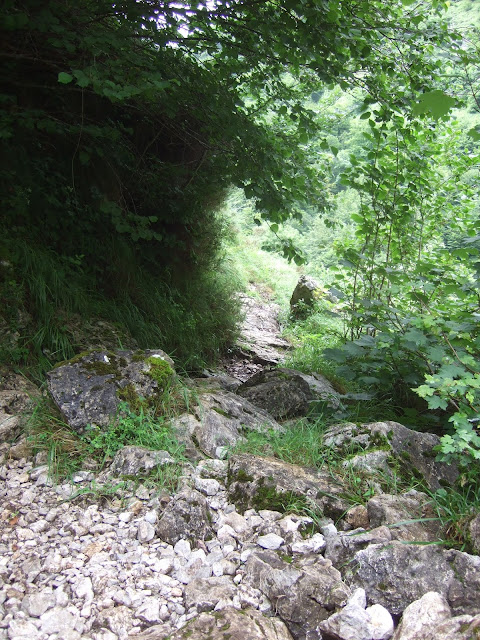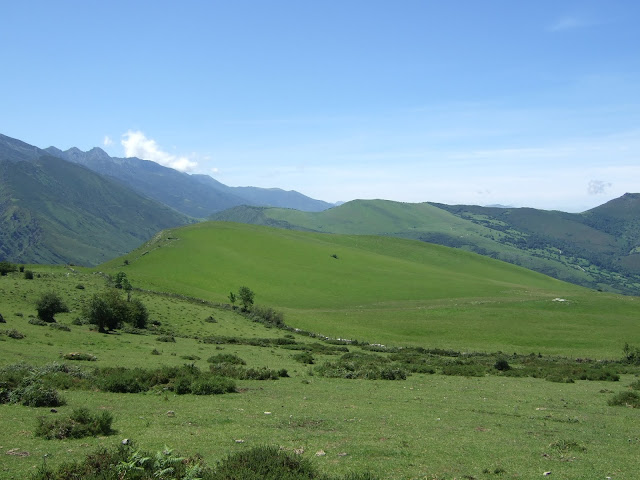Tenía en mi lista desde mucho tiempo la senda que bordea el río Dobra, afluente de Sella. En Amieva, donde dejé el coche, se veían muchas nubes bajas. No se levantaron en todo el día pero aun así pude disfrutar de las vistas del valle por donde discurre el río.
Taking advantage of the low temperatures forecast I got up early to do a long walk in Asturias. The clouds didn't lift at all, but as the walk followed a river there were lovely views to be had even if the mountains were hidden from view.
 |
| Hórreo-Amieva |
Por una pista que sale a la derecha desde la entrada al pueblo subí andando hasta el Cueto de Angón, aunque se puede subir en coche, ya que hay un pequeño aparcamiento en el collado. La ruta (PR-PNPE-7) está balizada, y continúa con una bajada hacia las casas que se ven al fondo.
I parked in Amieva and then walked up a narrow road to the right at the entrance to the village. There is a small carpark at the collado de Angón for those who wish to make the hike shorter; from that point the track carries straight on, heading down towards the two houses in the photo
 |
| Valle de Angón |
I passed the Restaño power station and saw the river Dobra for the first time, surrounded by exhuberant vegetation
Se cruza el río y comienza una subida a través del bosque. Una mirada atrás:
I crossd the river and walked up through the woods. A look back at the valley:
Se llega a Bellanzo
The climb levels off at Bellanzo
Cerca está la Presa de la Jocica. Merece la pena leer la información en un panel sobre la construcción de la misma. Un poco más adelante vi una placa en memoria de un joven que fallecía en 1948 - me preguntaba si tendría que ver con las obras...
Nearby is the Jocica dam
Y a partir de ahí seguí la Senda de la Jocica, que sube por la margen derecha del río, manteniéndose a una distancia constante sobre el mismo
The continuation is named the Jocica path, which makes its way up the right-hand side of the river
 |
| Embalse de la Jocica |
It passes through very pretty spots
Antes había visto un escribano cerillo por primera vez en muchos años, pero aunque no conseguí una buena foto del pájaro, por lo menos esta mariposa fritillaria se quedó quieta.
Earlier on in the walk I'd seen a yellowhammer for the first time in years, but was unable to get a decent photo - this fritillary stayed still long enough though.
 |
Eventually you get to Carambo. Rather than returning the way I'd come, I'd decided to cross the river and link up with another path. From the hut in the photo I walked down to the river; the path isn't all that clear, and it's advisable to keep to the left when in doubt. I ignored a confusing signpost which seemed to be facing the wrong way and followed the obvious path to the bridge over the river
 |
| El Dobra |
On the other side the path was just about visible through the fern, but then leads uphill very clearly through pleasant woodland
En el Puerto de la Barcinera hay un cruce. A la izquierda se va al refugio de Vegabaño, pero yo seguí a la derecha siguiendo la señalización Soto/Beza. Esto ya es territorio leonés.
At the top of the hill (Puerto de la Barcinera) there's a crossroads. The left-hand path leads to the Vegabaño refuge, but I took the one to the right (signposted Soto/Beza). We are now in the province of León.
Aquí paré a comer. Ya llevaba casi 5 horas caminando. Esta mariposa llamada montañesa ojitos se colocó delante de mí y ya no se movió. Lo menos que podía hacer era inmortalizarla en mi blog
This mountain ringlet butterfly flew down in front of me while I sat for a bite to eat and didn't move thereafter. The least I could do was include it in my blog
Poco después hay una bifurcación. El camino de la izquierda baja a Soto de Sajambre y el sendero que cogí sube a la derecha hacia el Portillo de Beza. Queda unos 200 metros de subida suave que ofrece vistas bonitas hacia el sur. Ahora estamos en la provincia de León
Soon afterwards there's a fork in the track. The left-hand path goes down to Soto de Sajambre, but I took the one to the right (signposted Portilla de Beza) that goes uphill through lovely countryside offering views to the south.
 |
| Soto de Sajambre |
I walked round the foot of Beza, which was briefly visible through the cloud
Me parecía un sendero precioso
From the fork you go up 200 metres
Llegamos al Puerto de Beza, donde hay un abrevadero. No hay que ir más abajo que éste, sino mantener la misma dirección que traíamos y subir ligeramente hasta llegar a la Portilla de Beza. El nombre me había confundido un poco, porque en los mapas que traía, este sitio se denomina Portilla (o Cruz) de Tarabica, pero evidentemente es el mismo lugar, el punto más alto de la ruta (1.500m) y lo confirmaban los restos de un panel informativo sobre la Senda del Arcediano. Esto es el final de la PR-PNPE 7, pero sigue la GR-201. También es donde pasamos otra vez a Asturias.
We get to the Beza pastures, where there's a drinking trough. It's important not to follow the path leading down from here, but keep the same direction as before and go up a bit till you get to a gate in a stone wall. This is the Portillo de Beza, which marks the end of the signposted route followed thus far, though the GR-201 continues from here. We also leave León at this point and re-enter Asturias, as well as connecting up with the Senda del Arcediano, a historic pathway.
 |
| Puerto de Beza |
Bajando con tendencia a la izquierda se llega a la majada de Toneyu
I remember having done this walk in the other direction over 30 years ago and enjoying lovely views, but not today; low-lying cloud made it impossible to see anything any distance away.
We now go downhill towards the left and go past Toneyu
As the path isn't very clear here I needed to use the trail I'd previously downloaded, but all the same was relieved to see this sign, which coincided with the cobbled path becoming easier to follow.
Aunque no veía las cumbres, reconocía el valle de Angón hacia la derecha, por donde había pasado esa mañana
Although I couldn't see the peaks, I recognised the Angón valley I'd been through that morning over to the right
La última parte de la Senda es muy bonita, aunque en las zonas donde está mojada hay que ir con mucho cuidado
The last section of the path is particularly eye-catching, though you have to tread carefully where the cobblestones are wet
Al llegar al aparcamiento del collado de Angón me descuidé y casi me resbalo allí mismo. Me quedaba unos 40 minutos bajando por la carretera a Amieva. La nube se mantenía inamovible.
When I reached Angón, I relaxed and almost took a tumble right on the slope down to the carpark. Thereafter I had a 40-minute walk down the road I'd walked up that morning. The cloud was definitely staying put.
Aquí dejo un enlace al mapa de la ruta. Tardé 9 horas y media. Está claro que habría sido una excursión más bonita sin la nube baja, pero ¡por lo menos no pasé calor!
Here is a link to a map of the route I followed. I took 9 and a half hours. It would obviously have been a more spectacular hike without the cloud cover but there again, it would probably have been uncomfortably warm!















































